Related Research Articles
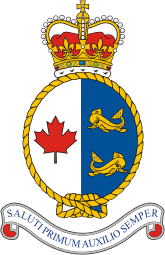
The Canadian Coast Guard is the coast guard of Canada. Formed in 1962, the coast guard is tasked with marine search and rescue (SAR), communication, navigation, and transportation issues in Canadian waters, such as navigation aids and icebreaking, marine pollution response, and support for other Canadian government initiatives. The Coast Guard operates 119 vessels of varying sizes and 23 helicopters, along with a variety of smaller craft. The CCG is headquartered in Ottawa, Ontario, and is a special operating agency within Fisheries and Oceans Canada.

Joseph Thomas Keable, VC, MM was a Canadian soldier during the First World War. Keable was a recipient of the Victoria Cross, the highest and most prestigious award for gallantry in the face of the enemy that can be awarded to British and Commonwealth forces. He was the first French Canadian soldier to be decorated with the VC and Military Medal.

CCGS Louis S. St-Laurent is a Canadian Coast Guard (CCG) heavy icebreaker. Louis S. St-Laurent's home port is St. John's, Newfoundland and Labrador. She is the largest icebreaker and flagship of the CCG.
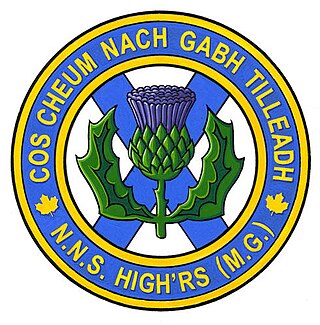
The North Nova Scotia Highlanders was an infantry regiment of the Canadian Army founded in 1936. In 1954, it was amalgamated with The Pictou Highlanders and 189 LAA RCA Battery to form 1st Battalion, The Nova Scotia Highlanders (North).
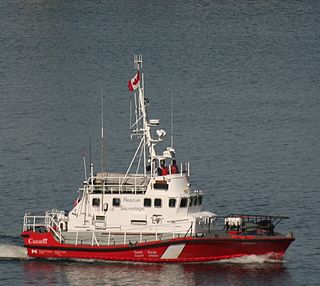
CCGS Westport is a Canadian Coast Guard search and rescue vessel homeported in Westport, Nova Scotia.

The Ardenne Abbey massacre occurred during the Battle of Normandy at the Ardenne Abbey, a Premonstratensian monastery in Saint-Germain-la-Blanche-Herbe, near Caen, France. In June 1944, 20 Canadian soldiers were massacred in a garden at the abbey by members of the 12th SS Panzer Division Hitlerjugend over the course of several days and weeks. This was part of the Normandy Massacres, a series of scattered killings during which up to 156 Canadian prisoners of war were murdered by soldiers of the 12th SS Panzer Division during the Battle of Normandy. The perpetrators of the massacre, members of the 12th SS Panzer Division, were known for their fanaticism, the majority having been drawn from the Hitlerjugend or Hitler Youth.
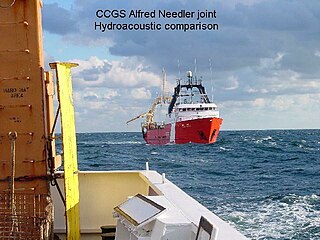
CCGS Alfred Needler is an offshore fishery science vessel formerly operated by the Canadian Coast Guard. The vessel entered service in 1982 with the Department of Fisheries and Oceans, stationed at the Bedford Institute of Oceanography in Dartmouth, Nova Scotia. In 1995, in order to reduce the number of ships and combine tasks, the Fisheries and Oceans fleet and the Canadian Coast Guard fleets were merged under the Canadian Coast Guard. The ship was decommissioned from Canadian Coast Guard service in 2023.

CCGS Sambro is a Canadian Coast Guard motor lifeboat homeported in Sambro, Nova Scotia.
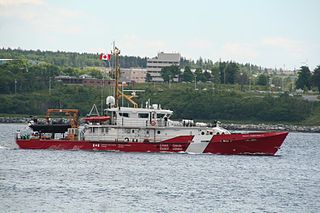
The Hero-class patrol vessels, previously the Mid-Shore Patrol Vessel Project, is a series of nine patrol vessels constructed by Halifax Shipyards for the Canadian Coast Guard. Based on the Dutch Damen Stan 4207 patrol vessel, construction began in 2011 and the first vessel entered service in 2012. The vessels are assigned to the Atlantic and Pacific coasts of Canada, used for coastal patrol duties.

The Canadian Coast Guard has had two motor lifeboats named CCGS Clarks Harbour. The first was a 13-metre (43 ft) vessel, which entered service in 1996.
CCGS Simon Fraser was a buoy tender operated by the Canadian Coast Guard. The vessel entered service in 1960 with the Department of Transport's Marine Fleet, before being transferred to the newly formed Canadian Coast Guard in 1962. The buoy tender served on both coasts of Canada and was used for search and rescue duties along the West Coast of Canada. The ship was loaned to the Royal Canadian Mounted Police in 2000 and transited the Northwest Passage, circumnavigating North America in the process. The ship was taken out of service in 2001 and sold to private interests. In 2006, the vessel reappeared as a yacht using the same name.
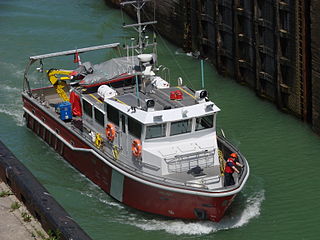
ABCO Industries is located on the waterfront of the UNESCO World Heritage Site-designated port town of Lunenburg, Nova Scotia.
CCGS S. Dudka is fishery protection vessel of the Canadian Coast Guard. She was built in Lunenberg, Nova Scotia, for $2.9 million CAD. She was launched on March 22, 2013. She was officially commissioned on July 11, 2013. Twenty-five descendants of Stanley Dudka, the ship's namesake, attended the commissioning. Dudka was a decorated veteran of World War II.

CCGS Captain Goddard M.S.M. is one of the Canadian Coast Guard's nine Hero-class patrol vessels. The ship entered service in 2014 and is based at Victoria, British Columbia on Canada's West Coast. The vessel's primary roles will be fishery and environmental patrols, border control, search and rescue.

CCGS Corporal Teather, C.V. is the third of nine of the Canadian Coast Guard's Hero-class patrol vessel. Constructed in 2013, the ship entered service the same year. Corporal Teather C.V. is based in Dartmouth, Nova Scotia, tasked with fisheries patrol and enforcement.

CCGS A. LeBlanc is the seventh of nine Hero-class patrol vessels operated by the Canadian Coast Guard. The ship entered service in 2014 and is based at Quebec City, Quebec. A. LeBlanc is tasked with enforcing Canadian maritime law within Canada's maritime borders.
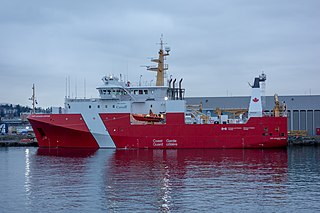
CCGS Capt. Jacques Cartier is an offshore fisheries research ship of the Canadian Coast Guard. The ship was ordered in 2011 as part of the Canadian National Shipbuilding Procurement Strategy (NSPS) as a replacement for aging Canadian Coast Guard vessels. Capt. Jacques Cartier is the sister ship of CCGS Sir John Franklin and CCGS John Cabot. The ship was constructed at Seaspan Shipyard, Vancouver, British Columbia and launched on 5 June 2019.
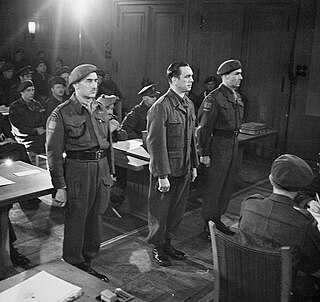
The Normandy massacres were a series of killings in-which approximately 156 Canadian and two British prisoners of war (POWs) were murdered by soldiers of the 12th SS Panzer Division during the Battle of Normandy in World War II. The majority of the murders occurred within the first ten days of the Allied invasion of France. The killings ranged in scale from spontaneous murders of individual POWs, to premeditated mass executions involving dozens of victims. Colonel Kurt Meyer, a commander in the 12th SS Panzer Division, was the only perpetrator charged for his role in the atrocities.
References
- ↑ David Pugliese (2013-07-11). "New Coast Guard Vessel Arrives – Named After Second World War Hero". Ottawa Citizen. Archived from the original on 2013-08-10.
- 1 2 3 4 5 "Minister Ashfield Announces the Acceptance of the CCGS S. Dudka". Dartmouth, Nova Scotia: Fisheries and Oceans Canada. 2013-03-22. Archived from the original on 2013-07-06. Retrieved 2013-08-10.
The Honourable Keith Ashfield, Minister of Fisheries and Oceans and Minister responsible for the Atlantic Gateway, today announced the acceptance of the CCGS S. Dudka, a new Canadian Coast Guard specialty vessel which will be used primarily to support the conservation and protection of fisheries resources.
- 1 2 3 4 5 John Brennan (2013-07-11). "S. Dudka joins the Coast Guard's fleet". Alberton, Prince Edward Island: The News (New Glasgow) . Retrieved 2013-08-10.
Dudka landed at Juno Beach with the North Nova Scotia Highlanders as part of the D-Day landings on June 6, 1944, in Normandy, France. He was injured several times yet continued to fight. The next day, he was captured by enemy forces. While in captivity, he witnessed the murder of Canadian prisoners by enemy soldiers under the command of SS General Kurt Meyer.
- ↑ "Nova Scotia ex-POW Dudka dies". CBC News. 2008-03-07. Retrieved 2013-08-10.
Sgt. Dudka, born in New Glasgow, was captured after the D-Day invasion and was among those who helped convict SS Gen. Kurt Meyer in the execution of Canadian prisoners of war.
- 1 2 Eric McCarthy (2013-07-11). "Ship's naming a special honour for Dudka family". Northport, Prince Edward Island: Journal Pioneer. Archived from the original on 2022-06-07. Retrieved 2013-08-10.
Kent MacRae, Summerside field office supervisor with Fisheries and Oceans, said the vessel surpasses its predecessor, the CCGS Cheverie in many ways. It has greater range, almost double the speed and can carry a larger complement of fisheries officers. Its communication suite allows for immediate access to information and it is better equipped for surveillance, he said, although he declined to discuss those capabilities.